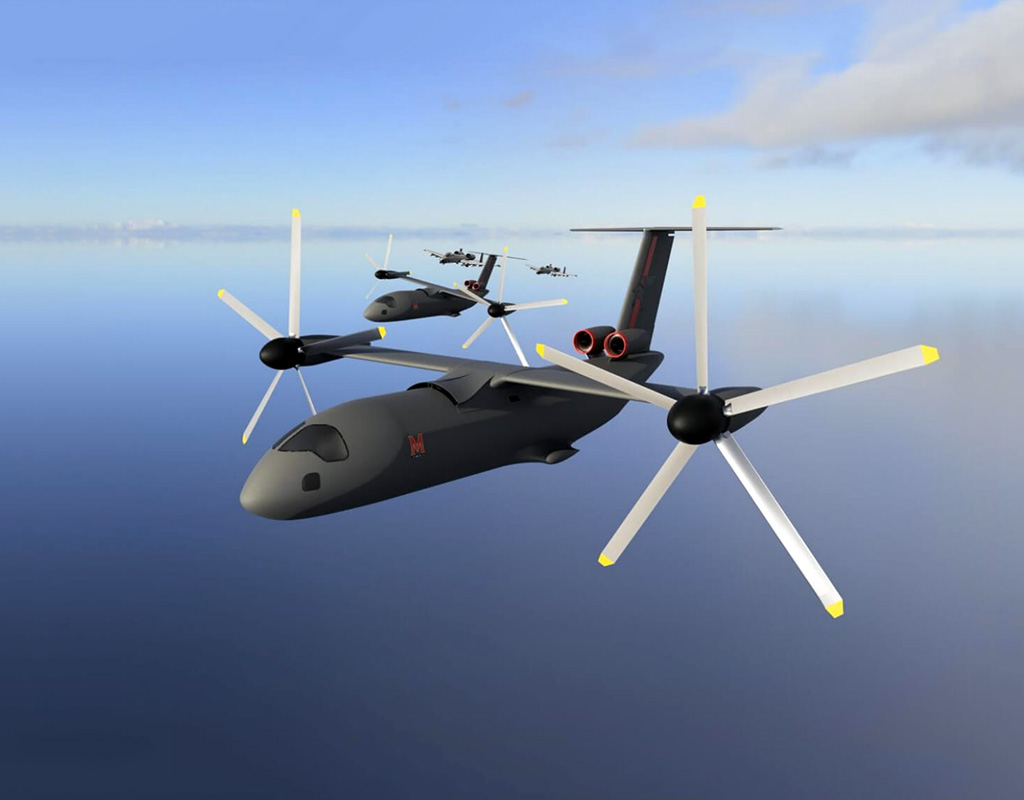
The Vertical Flight Society (VFS) has announced the winners of its 40th Annual Student Design Competition.
The team of University of Maryland took first place in the Graduate category and Georgia Institute of Technology/U.S. Military Academy in the Undergraduate category.
In addition, the Military Institute of Technology (Bangladesh) took Best New Undergraduate Entrant honors. Sikorsky, a Lockheed Martin Co. was the sponsor of this year’s competition with a total of $12,500 in prize money.
Each year, the VFS competition challenges students to design a vertical takeoff and landing (VTOL) aircraft that meets specified requirements, providing a practical exercise for engineering students at colleges and universities to promote student interest in VTOL engineering and technology.
Academic teams from around the world submitted entries in this year’s competition, with a total of 13 proposals from four different countries. Executive summaries for the top-winning entries from the 40th Student Design Competition are available at www.vtol.org/sdc, along with past winners.
The 40th (2022-2023) Student Design Competition was entitled, “High-Speed Vertical Takeoff and Landing (HSVTOL) Aircraft.” The goal of this year’s request for proposals (RFP) was to design a large VTOL aircraft that would balance sustained hover operations with high-speed and high-altitude cruise capabilities.
Students had to design an aircraft capable of carrying a payload of 5,000 pounds (2,268 kilograms) within an internal cargo bay with dimensions of 6.5 feet (1.98 meters) high, 8 feet (2.43 meters) wide and 30 feet (9.14 meters) long at a mission radius of action of 500 nautical miles (926 kilometers) and a cruise speed of no less than 450 knots (833 kilometers/hour) at a threat-avoidance altitude greater than 20,000 feet (6,096 meters) mean sea level (MSL).
The vehicle design also needed to include features to mitigate the severity of the outwash/downwash environment on ground personnel, as well as minimize the susceptibility of the propulsion system to foreign object debris (FOD) ingestion during VTOL operations.
The winning teams for the graduate category are as follows:
| Place | University (Graduate) | City, Country | Design Team |
| 1st | University of Maryland | College Park, Maryland, USA | Arion |
| 2nd | Georgia Institute of Technology Sapienza University | Atlanta, Georgia, USA Rome, Italy | Soteria |
| 3rd | Politecnico di Milano | Milan, Italy | Raven 4 |
The winning entry in the graduate category was University of Maryland’s “Arion” — named for the immortal mythical horse that was known for his extraordinary speed and bravery. The team’s design is a 48,000-pound (21,800-kilogram) mixed-power tiltrotor with two 39-foot (11.9-meters) proprotors.
Arion is powered by two inboard turboshaft engines plus two turbofans on the base of the tail for additional forward thrust.

The winning teams for the undergraduate category are as follows:
| Place | University (Undergraduate) | City, Country | Design Team |
| 1st | Georgia Institute of Technology/ US Military Academy | Atlanta, Georgia, USA West Point, New York, USA | The Harpy |
| 2nd | University of Maryland | College Park, Maryland, USA | Karfi |
| 3rd | Pennsylvania State University | State College, Pennsylvania, USA | NightFury |
| Best New Entrant | Military Institute of Science & Technology | Mirpur Contonment, Dhaka, Bangladesh | MIST AVRO |
The team of Georgia Institute of Technology and The U.S. Military Academy was the winning undergraduate team with its “Harpy” concept. The name was inspired by harpy eagles known for carrying heavy weights and harpies from mythology which are half-human and half-bird — much like the team’s design, which is half-VTOL and half-jet.
The 51,500-pound (23,350-kilogram) vehicle leverages a novel configuration of its two 36-feet (20-meter) diameter, two-bladed rotors mounted on the wingtips: for high-speed forward flight, the rotors are stopped, and its retreating blades are stored in the wings.
This method allows the drag to be minimized while still allowing the advancing blades to remain as useful lifting surfaces in the flow. The aircraft is powered by two convertible engine system technology (CEST) turbofan/turboshaft engines to drive the rotors and provide cruise thrust.
Two members of each of the first-place winning teams are invited to the 80th Annual Forum & Technology Display (www.vtol.org/forum) — scheduled for May 7 to 9, 2024 in Montreal, Canada — to present the details of their designs.
The Annual Student Design Competition sponsorship rotates between Airbus Helicopters, Bell, The Boeing Co., Bell, Leonardo, Sikorsky, a Lockheed Martin Co., and the DEVCOM Army Research Lab.
As announced previously, the 2023–2024 RFP for the 41st Annual Student Design Competition, sponsored by DEVCOM Army Research Laboratory, is also now available at www.vtol.org/sdc. A total of $12,500 in cash prizes is again available to the winning student teams. University teams must submit a letter of intent to participate no later than Feb. 1, 2024.
This new RFP is entitled, “Multi-Mission Modular UAS for Disaster Relief,” and challenges students with designing a multi-mission, modular, VTOL uncrewed aircraft system (UAS) that can: take off and land vertically from the deck of a ship in high-winds and gusty conditions; cruise to and from the site of a disaster; and serve as a long-endurance communications relay or land vertically to deliver relief supplies.

